竞争优势模型【外文翻译】
- 格式:doc
- 大小:50.50 KB
- 文档页数:9
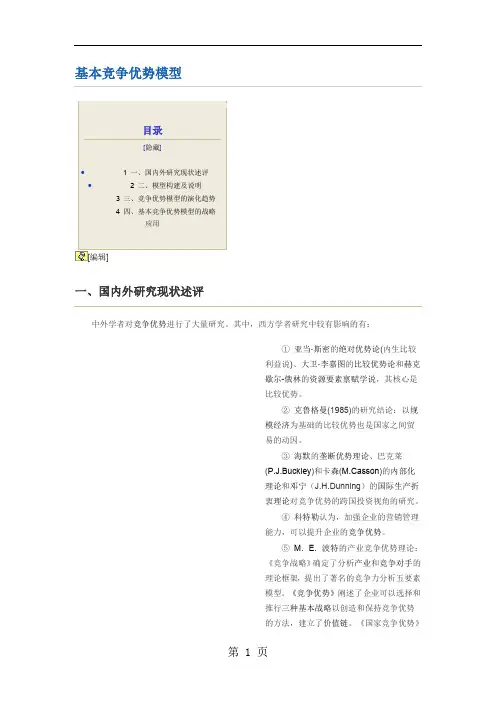
基本竞争优势模型[编辑]一、国内外研究现状述评中外学者对竞争优势进行了大量研究。
其中,西方学者研究中较有影响的有:①亚当·斯密的绝对优势论(内生比较利益说)、大卫·李嘉图的比较优势论和赫克歇尔-俄林的资源要素禀赋学说,其核心是比较优势。
②克鲁格曼(1985)的研究结论:以规模经济为基础的比较优势也是国家之间贸易的动因。
③海默的垄断优势理论、巴克莱(P.J.Buckley)和卡森(M.Casson)的内部化理论和邓宁(J.H.Dunning)的国际生产折衷理论对竞争优势的跨国投资视角的研究。
④科特勒认为,加强企业的营销管理能力,可以提升企业的竞争优势。
⑤M.E.波特的产业竞争优势理论:《竞争战略》确定了分析产业和竞争对手的理论框架,提出了著名的竞争力分析五要素模型。
《竞争优势》阐述了企业可以选择和推行三种基本战略以创造和保持竞争优势的方法,建立了价值链。
《国家竞争优势》(1990)认为国家应该创造一个良好的经营环境和支持性制度,以确保投入要素能够高效地使用和升级换代。
钻石理论的六要素分析框架,对产业国际竞争力(优势)研究做出了非常有价值的贡献。
⑥哈默和普拉哈拉德(1990)提出企业的竞争优势来源于企业的核心能力。
⑦安德鲁斯等提出的SWOT分析法。
⑧戴维德·梯斯(David Teece,大卫·梯斯)(2019)强调,企业必须通过创新以适应环境获取竞争优势。
近年来,国内有关竞争优势研究的主要观点有:①陈佳贵(2019)指出,在新的竞争格局中培育竞争优势,政府要创造公平竞争环境和必要条件,企业要学习和适应新的竞争规则,提升国际竞争力。
②李海舰等(2019)研究发现,企业竞争优势来源于产业景气、战略群组和核心能力。
③张金昌认为,企业的竞争力关键在于企业的总体创新能力。
④杨瑞龙认为,企业竞争优势取决于企业对资源的整合能力,多种能力与企业的特有的制度环境、文化环境有关系。
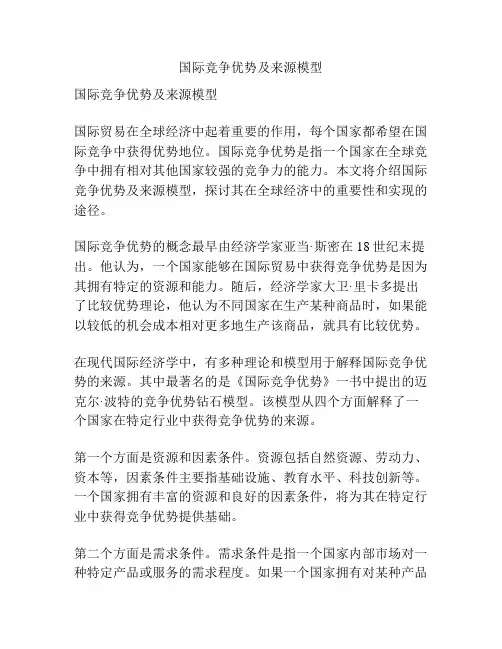
国际竞争优势及来源模型国际竞争优势及来源模型国际贸易在全球经济中起着重要的作用,每个国家都希望在国际竞争中获得优势地位。
国际竞争优势是指一个国家在全球竞争中拥有相对其他国家较强的竞争力的能力。
本文将介绍国际竞争优势及来源模型,探讨其在全球经济中的重要性和实现的途径。
国际竞争优势的概念最早由经济学家亚当·斯密在18世纪末提出。
他认为,一个国家能够在国际贸易中获得竞争优势是因为其拥有特定的资源和能力。
随后,经济学家大卫·里卡多提出了比较优势理论,他认为不同国家在生产某种商品时,如果能以较低的机会成本相对更多地生产该商品,就具有比较优势。
在现代国际经济学中,有多种理论和模型用于解释国际竞争优势的来源。
其中最著名的是《国际竞争优势》一书中提出的迈克尔·波特的竞争优势钻石模型。
该模型从四个方面解释了一个国家在特定行业中获得竞争优势的来源。
第一个方面是资源和因素条件。
资源包括自然资源、劳动力、资本等,因素条件主要指基础设施、教育水平、科技创新等。
一个国家拥有丰富的资源和良好的因素条件,将为其在特定行业中获得竞争优势提供基础。
第二个方面是需求条件。
需求条件是指一个国家内部市场对一种特定产品或服务的需求程度。
如果一个国家拥有对某种产品或服务的高度需求,将为其在该行业中的竞争优势提供动力。
比如,日本以对电子产品的高需求而在该行业中获得了竞争优势。
第三个方面是相关和支持性产业的发展。
相关和支持性产业是指与特定行业紧密相关的产业和机构。
发展相关和支持性产业将为特定行业提供配套的产品和服务,并促进技术创新和知识交流。
最后一个方面是企业战略和结构,即企业在特定行业中的战略选择和组织结构。
企业的竞争力取决于其在产品创新、市场定位、品牌形象等方面的能力。
除了竞争钻石模型,还有其他一些模型用于解释国际竞争优势的来源。
比如,里卡多的比较优势理论侧重于资源配置和成本效益;霍兰斯朗的国际产品生命周期模型侧重于技术创新和产品发展;关税税则理论侧重于国际贸易政策对国际竞争优势的影响。
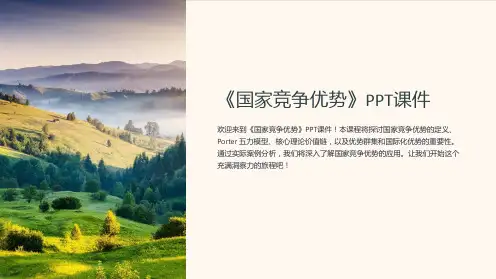
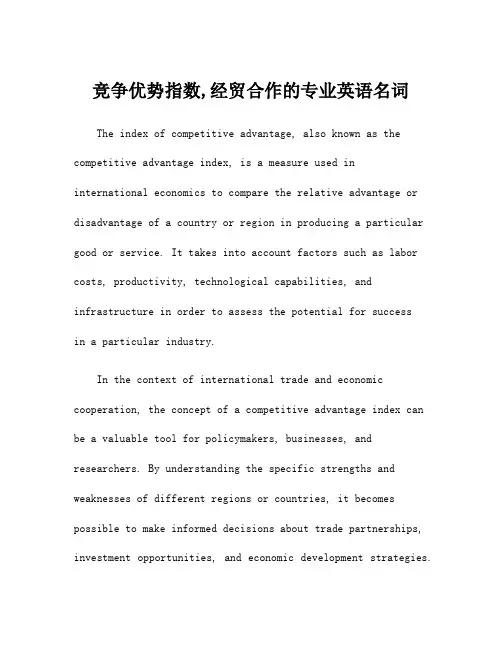
竞争优势指数,经贸合作的专业英语名词The index of competitive advantage, also known as the competitive advantage index, is a measure used ininternational economics to compare the relative advantage or disadvantage of a country or region in producing a particular good or service. It takes into account factors such as labor costs, productivity, technological capabilities, and infrastructure in order to assess the potential for successin a particular industry.In the context of international trade and economic cooperation, the concept of a competitive advantage index can be a valuable tool for policymakers, businesses, and researchers. By understanding the specific strengths and weaknesses of different regions or countries, it becomes possible to make informed decisions about trade partnerships, investment opportunities, and economic development strategies.For example, when negotiating a trade agreement, a country may use the competitive advantage index to identify potential areas of collaboration or compromise with its trading partners. Similarly, businesses looking to expandinto new markets can use the index to assess the viability of their products or services in different regions.In summary, the competitive advantage index plays a critical role in shaping the landscape of international trade and economic cooperation. By providing a standardized measure of comparative advantage, it enables stakeholders to make informed decisions that can lead to mutually beneficial outcomes for all parties involved.。

人力资源毕业论文参考文献外文原文翻译————————————————————————————————作者: ————————————————————————————————日期:文章出处:Human Systems Management 28 (2009) 47–56DOI 10.3233/HSM-2009-0692 IOS Press纵向研究调查战略人力资源管理在法国中小企业中的应用阿卜杜勒-瓦哈卜Aït Razouk和穆罕默德贝亚德(节选) 简介战略人力资源管理已经在近几年内取得了很大的进步,并且已经达成了广泛的共识。
影响经济的几个因素中,技术和人口的变化推动了公司重新考虑这个地方的人力资源,以及改变了他们的管理模式,特别是人力资源管理的方法。
制度约束的减弱也提高了人力资源管理的灵活做法。
传统上人力资源管理的主要功能是负责人力资源的行政管理,他们尽可能的减少成本控制。
战略人力资源管理派系不同意这种看法,他们认为人力资源是一种资源,它需要战略方法的投资。
这些措施对发展和保留能力去改善公司业绩有吸引力。
然而,如果在北美的研究学者认为战略人力资源管理在大公司是适用的,那么是欧洲的公司更具体的说是法国公司也适用吗?法国中小企业适用这种战略人力资源管理方法吗?我们要想了解这些问题必须先去了解战略人力资源管理在美国的环境。
在Heneman等人的文章里,在美国以外的国家已经很少注意到中小企业的人力资源管理实务的研究。
这些作者断言:“用全球的观点来看其它国家可以是填充美国知识空隙的资源之一,在一种文化中适用另外一种文化需要采取保护措施”。
法国环境是这个领域的一个有趣的反例,因为它的法律和制度的制约,在一些特殊的工会,尽管在过去的十年里它们有弱化的现象。
根据这份研究,我们将试着丰富在中小企业中我们的战略人力资源管理的知识。
在研究中特别是法国的中小企业战略人力资源管理仍然没有得到很好的发展。
我们通过参与学习法国中小企业可以证明他们有能力改变是可以创造财富的。

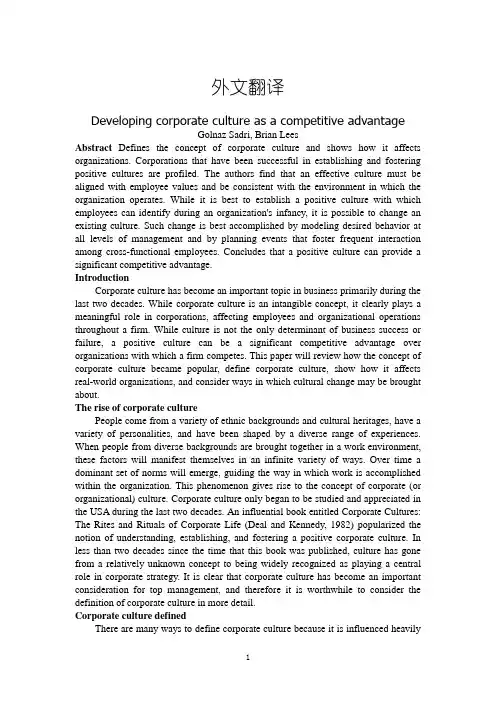
外文翻译Developing corporate culture as a competitive advantageGolnaz Sadri, Brian LeesAbstract Defines the concept of corporate culture and shows how it affects organizations. Corporations that have been successful in establishing and fostering positive cultures are profiled. The authors find that an effective culture must be aligned with employee values and be consistent with the environment in which the organization operates. While it is best to establish a positive culture with which employees can identify during an organization's infancy, it is possible to change an existing culture. Such change is best accomplished by modeling desired behavior at all levels of management and by planning events that foster frequent interaction among cross-functional employees. Concludes that a positive culture can provide a significant competitive advantage.IntroductionCorporate culture has become an important topic in business primarily during the last two decades. While corporate culture is an intangible concept, it clearly plays a meaningful role in corporations, affecting employees and organizational operations throughout a firm. While culture is not the only determinant of business success or failure, a positive culture can be a significant competitive advantage over organizations with which a firm competes. This paper will review how the concept of corporate culture became popular, define corporate culture, show how it affects real-world organizations, and consider ways in which cultural change may be brought about.The rise of corporate culturePeople come from a variety of ethnic backgrounds and cultural heritages, have a variety of personalities, and have been shaped by a diverse range of experiences. When people from diverse backgrounds are brought together in a work environment, these factors will manifest themselves in an infinite variety of ways. Over time a dominant set of norms will emerge, guiding the way in which work is accomplished within the organization. This phenomenon gives rise to the concept of corporate (or organizational) culture. Corporate culture only began to be studied and appreciated in the USA during the last two decades. An influential book entitled Corporate Cultures: The Rites and Rituals of Corporate Life (Deal and Kennedy, 1982) popularized the notion of understanding, establishing, and fostering a positive corporate culture. In less than two decades since the time that this book was published, culture has gone from a relatively unknown concept to being widely recognized as playing a central role in corporate strategy. It is clear that corporate culture has become an important consideration for top management, and therefore it is worthwhile to consider the definition of corporate culture in more detail.Corporate culture definedThere are many ways to define corporate culture because it is influenced heavilyby factors such as the industry in which the company operates, its geographic location, events that have occurred during its history, the personalities of its employees, and th eir patterns of interaction. Some of the formal definitions offered include “ a cognitive framework consisting of attitudes, values, behavioral norms, and expectations”, “the collective thoughts, habits, attitudes, feelings, and patterns of behavior”, and “the pattern of arrangement, material or behavior which has been adopted by a society (corporation, group, or team) as the accepted way of solving problems”. In more useful terms, a positive corporate culture typically encompasses several key elements. First, it is fostered not merely by a mission statement, but by a clear corporate vision, which is a mental picture of the company's desired future. Corporate visions are most effective when clearly communicated by top organizational leaders who exhibit strong values and have dynamic, charismatic personalities. Second, corporate culture is supported by corporate values that are consistent with the purpose of the company and aligned with the personal values of organizational members. Corporate vision and values permeate all levels of the organization and are consistently modeled by top management. Third, employees are highly valued at all levels of the organization (they are often referred to as ``associates'' or ``team members''), and there is extensive employee interaction both within and across functional departments. Fourth, the culture is adaptable, adjusting quickly in response to external conditions and is consistent, treating all employees equally and fairly. Finally, corporate culture is perpetuated in some way, perhaps through tangible symbols, slogans, stories, or ceremonies that highlight corporate values.The aforementioned characteristics of a positive culture cannot exist without widespread employee support. Even within an organization that has a strong overall culture, there will also be many subcultures. These could form for many reasons, perhaps due to functional differences in the organization, or to ethnic or geographic differences among employees. The dominant culture in the organization must be strong enough for members of various subcultures within the organization to identify with, accept and embrace it. This necessarily requires that the values of the dominant culture be aligned with the values of each of the subcultures as well as the personal values of each individual.Categorizing corporate cultureIn order to provide a basis for further analysis, researchers have sought to place corporate cultures into general categories. One such categorization by Sonnenfeld defines four types of cultures: the academy, the club, the baseball team, and the fortress. The academy exposes employees to many different jobs so that they can move around within the organization. The club is very concerned with how people will fit in to the organization. The baseball team consists of talented people or ``stars'' that are rewarded heavily for their accomplishments but who will readily leave the organization when a better opportunity comes along. The fortress is an organization that is concerned mainly with survival.Goffee and Jones offer another categorization, postulating that corporate culture is determined by levels of sociability (a measure of sincere friendliness amongmembers of a community) and solidarity (a community's ability to pursue shared objectives quickly and effectively) and they have developed a survey that can aid in understanding where an organization fits on this scale. The combination of these dimensions gives rise to categories that they have labeled as networked, mercenary, fragmented, and communal. None of these categories is considered to be better than the others. Instead, they serve as a way for management to determine where their culture fits relative to other types of cultures. A networked culture is distinguished by high sociability and low solidarity. Individuals in this type of culture feel like family and socialize often. Promotions are achieved and work is accomplished via informal networks or subcultures within the organization. This corresponds loosely with Sonnenfeld's club category. A mercenary culture has low sociability and high solidarity. Individuals do not interact socially but are united in supporting strategic business objectives. They do not tend to exhibit a strong degree of loyalty, staying only as long as their personal needs continue to be met. This category is similar to Sonnenfeld's baseball team. A fragmented culture has low sociability and low solidarity. People in This type of organization rarely interact. They may work with their office doors shut or from home. This type of culture might be found in a law office or in a company that is downsizing. This category would be similar to Sonnenfeld's fortress.Finally, a communal organization has high sociability and high solidarity. This type of culture is often found in small start-up companies. Members of such an organization work very closely together for long hours and will likely socialize together. They strongly identify with the corporate culture and have a high sense of fairness so that rewards are shared equally. This category is most similar to Sonnenfeld's academy.Categorizing an organization's culture can help managers in several ways. First, categorizing the culture is a precursor to better understanding the pros and cons of that particular type of culture. Second, a clear understanding of their corporate culture can assist managers in getting the correct person-organization match when recruiting for new employees. Third, knowing where a company is right now can assist managers in making decisions about and progress toward cultural change.Benefits of a positive cultureAn organization that is able to maintain a positive culture is likely to enjoy many benefits. When organization members identify with the culture, the work environment tends to be more enjoyable, which boosts morale. This leads to increased levels of teamwork, sharing of information, and openness to new ideas. The resulting increased interaction among employees activates learning and continuous improvement because information flows more freely throughout the organization. Additionally, such a culture helps to attract and retain top employees, evidenced by books such as The 100 Best Companies to Work for in America in which culture is emphasized as a primary determinant of the attractiveness of an employer. When considering corporate culture, it is helpful to consider actual companies that have demonstrated the positive effects that a corporate culture can have.Changing corporate cultureA lot of examples show that a positive culture can make a significant contribution to organizational success while a negative one can lead to failure.While it is easiest to establish a desirable corporate culture during a company's infancy, it has been shown in practice that culture can be changed for the better. In order to go about changing corporate culture, top management must first understand the culture, as it exists today. This can be accomplished by surveying employees on important topics such as their perceptions of and identification with the corporate values and mission, interactions with other employees both inside and outside of their departments, beliefs about whether they are treated fairly, and so on. This will help management to determine the type of culture that exists and to identify areas for change.Once the current culture is understood, management must decide how the culture should be changed in order to improve results. For a culture to be effective, it should be consistent with the business environment in which the organization operates. For example, high technology firms tend to operate better using a culture that encourages sharing of information and that responds quickly to external events. As discussed previously, sharing of information and quick response to external events are fostered by frequent interaction among employees across organizational functions. If management wishes to encourage this type of behavior, they should plan events that foster more interaction among employees such as social events and ceremonies.Management should seek cultural change by modeling the behavior that they wish to encourage, and then reinforce the desired culture by taking steps such as developing visionary statements and/or slogans, celebrating employees' successes or promotions, distributing newsletters and videos that reinforce the culture, recruiting new people into the organization that are compatible with the desired culture, changing dress codes, and so on.ConclusionThis paper defined the term corporate culture and considered the rise in popularity of corporate culture in recent decades. We also looked at two different ways in which corporations can categorize their culture, and considered the benefits of a positive culture to organizations such as Wal-Mart, Southwest Airlines and Hewlett Packard. Finally, we suggested that while a positive culture should be established during a company's infancy, it is possible to change a corporation's culture should it be necessary to do so. Today's globally-competitive business environment has made a positive corporate culture a critical aspect of success for firms. No longer just a competitive advantage, it has become a prerequisite for success, allowing companies to attract and retain top employees. We strongly recommend that organizations of all sizes assess and categorize their corporate cultures, looking in particular at the impact of that culture on employee productivity and morale. Where the culture is serving to lower morale, we recommend that management take proactive steps to change the corporate culture using a top-down approach, establishing a new vision and demonstrating new behavior consistent with the revised vision. Much like national culture, our understanding of corporate culture and its impact on employee behavior is still in its infancy but one thing is for sure, culture can have a tremendouspositive impact on employees. In conclusion, we urge companies to shape their corporate culture to their advantage in improving both their employees' experience of the workplace and, in turn, improving their own profitability.Resource: Journal of Management Development 2010,853-859译文开发企业文化作为一种竞争优势资料来源: 《管理学发展》2010.第853-859页作者:格纳茨·桑德里,布莱恩·李斯摘要定义企业文化的概念,并阐述他是如何影响组织的。
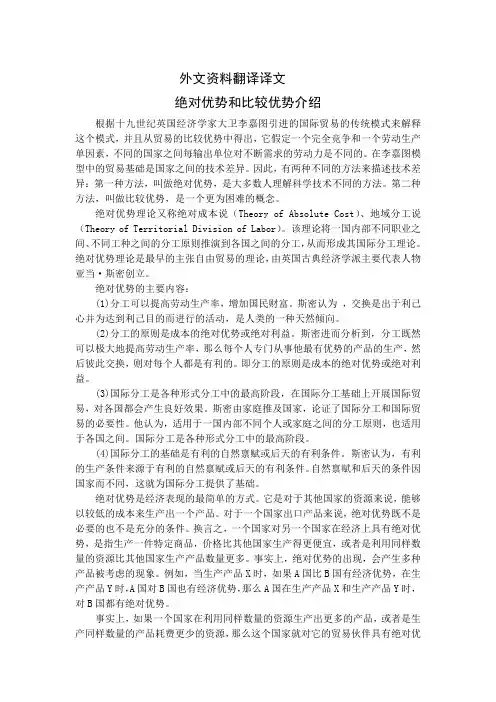
矿产资源开发利用方案编写内容要求及审查大纲
矿产资源开发利用方案编写内容要求及《矿产资源开发利用方案》审查大纲一、概述
㈠矿区位置、隶属关系和企业性质。
如为改扩建矿山, 应说明矿山现状、
特点及存在的主要问题。
㈡编制依据
(1简述项目前期工作进展情况及与有关方面对项目的意向性协议情况。
(2 列出开发利用方案编制所依据的主要基础性资料的名称。
如经储量管理部门认定的矿区地质勘探报告、选矿试验报告、加工利用试验报告、工程地质初评资料、矿区水文资料和供水资料等。
对改、扩建矿山应有生产实际资料, 如矿山总平面现状图、矿床开拓系统图、采场现状图和主要采选设备清单等。
二、矿产品需求现状和预测
㈠该矿产在国内需求情况和市场供应情况
1、矿产品现状及加工利用趋向。
2、国内近、远期的需求量及主要销向预测。
㈡产品价格分析
1、国内矿产品价格现状。
2、矿产品价格稳定性及变化趋势。
三、矿产资源概况
㈠矿区总体概况
1、矿区总体规划情况。
2、矿区矿产资源概况。
3、该设计与矿区总体开发的关系。
㈡该设计项目的资源概况
1、矿床地质及构造特征。
2、矿床开采技术条件及水文地质条件。
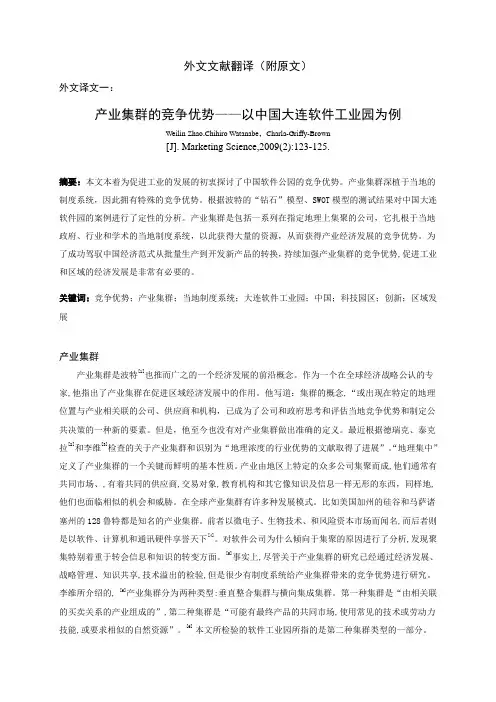
外文文献翻译(附原文)外文译文一:产业集群的竞争优势——以中国大连软件工业园为例Weilin Zhao,Chihiro Watanabe,Charla-Griffy-Brown[J]. Marketing Science,2009(2):123-125.摘要:本文本着为促进工业的发展的初衷探讨了中国软件公园的竞争优势。
产业集群深植于当地的制度系统,因此拥有特殊的竞争优势。
根据波特的“钻石”模型、SWOT模型的测试结果对中国大连软件园的案例进行了定性的分析。
产业集群是包括一系列在指定地理上集聚的公司,它扎根于当地政府、行业和学术的当地制度系统,以此获得大量的资源,从而获得产业经济发展的竞争优势。
为了成功驾驭中国经济范式从批量生产到开发新产品的转换,持续加强产业集群的竞争优势,促进工业和区域的经济发展是非常有必要的。
关键词:竞争优势;产业集群;当地制度系统;大连软件工业园;中国;科技园区;创新;区域发展产业集群产业集群是波特[1]也推而广之的一个经济发展的前沿概念。
作为一个在全球经济战略公认的专家,他指出了产业集群在促进区域经济发展中的作用。
他写道:集群的概念,“或出现在特定的地理位置与产业相关联的公司、供应商和机构,已成为了公司和政府思考和评估当地竞争优势和制定公共决策的一种新的要素。
但是,他至今也没有对产业集群做出准确的定义。
最近根据德瑞克、泰克拉[2]和李维[3]检查的关于产业集群和识别为“地理浓度的行业优势的文献取得了进展”。
“地理集中”定义了产业集群的一个关键而鲜明的基本性质。
产业由地区上特定的众多公司集聚而成,他们通常有共同市场、,有着共同的供应商,交易对象,教育机构和其它像知识及信息一样无形的东西,同样地,他们也面临相似的机会和威胁。
在全球产业集群有许多种发展模式。
比如美国加州的硅谷和马萨诸塞州的128鲁特都是知名的产业集群。
前者以微电子、生物技术、和风险资本市场而闻名,而后者则是以软件、计算机和通讯硬件享誉天下[4]。
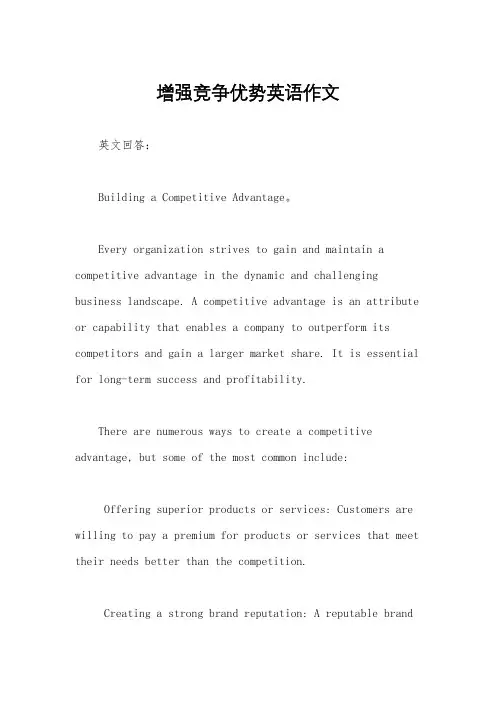
增强竞争优势英语作文英文回答:Building a Competitive Advantage。
Every organization strives to gain and maintain a competitive advantage in the dynamic and challenging business landscape. A competitive advantage is an attribute or capability that enables a company to outperform its competitors and gain a larger market share. It is essential for long-term success and profitability.There are numerous ways to create a competitive advantage, but some of the most common include:Offering superior products or services: Customers are willing to pay a premium for products or services that meet their needs better than the competition.Creating a strong brand reputation: A reputable brandcan attract customers and build loyalty.Developing a unique business model: A unique business model can help a company stand out from the competition and appeal to a specific niche market.Building a strong team: A talented and motivated workforce can help a company develop innovative productsand services and deliver excellent customer service.Investing in technology: Technology can help a company improve its efficiency, productivity, and customer service.Once a company has identified its competitive advantage, it needs to develop and implement strategies to maintainand enhance it. This may involve investing in research and development, marketing, sales, or customer service. It is also important to monitor the competition and identify new trends in the market.By continuously improving and evolving its competitive advantage, a company can stay ahead of the competition andachieve long-term success.中文回答:增强竞争优势。
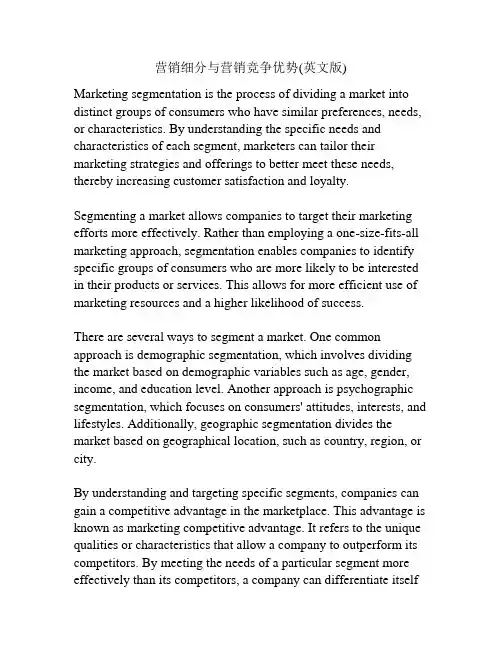
营销细分与营销竞争优势(英文版)Marketing segmentation is the process of dividing a market into distinct groups of consumers who have similar preferences, needs, or characteristics. By understanding the specific needs and characteristics of each segment, marketers can tailor their marketing strategies and offerings to better meet these needs, thereby increasing customer satisfaction and loyalty.Segmenting a market allows companies to target their marketing efforts more effectively. Rather than employing a one-size-fits-all marketing approach, segmentation enables companies to identify specific groups of consumers who are more likely to be interested in their products or services. This allows for more efficient use of marketing resources and a higher likelihood of success.There are several ways to segment a market. One common approach is demographic segmentation, which involves dividing the market based on demographic variables such as age, gender, income, and education level. Another approach is psychographic segmentation, which focuses on consumers' attitudes, interests, and lifestyles. Additionally, geographic segmentation divides the market based on geographical location, such as country, region, or city.By understanding and targeting specific segments, companies can gain a competitive advantage in the marketplace. This advantage is known as marketing competitive advantage. It refers to the unique qualities or characteristics that allow a company to outperform its competitors. By meeting the needs of a particular segment more effectively than its competitors, a company can differentiate itselfand attract more customers.There are several strategies that companies can employ to achieve a marketing competitive advantage. One strategy is offering superior products or services that meet the specific needs of a target segment. By focusing on product differentiation, companies can position themselves as the preferred choice for customers within a particular segment.Another strategy is providing exceptional customer service. By offering personalized support and assistance, companies can build stronger relationships with their target segments, resulting in higher customer satisfaction and loyalty. Additionally, companies can leverage technology and data to provide personalized marketing messages and offers to specific segments, further enhancing their competitive advantage.In conclusion, marketing segmentation is a crucial process that allows companies to divide a market into distinct groups based on their preferences, needs, or characteristics. By understanding and targeting specific segments, companies can gain a marketing competitive advantage by offering tailored products, superior customer service, and personalized marketing messages. This leads to increased customer satisfaction, loyalty, and ultimately, business success.细分市场是一项关键的营销策略,能够帮助企业更好地理解消费者需求和行为,并制定针对性的营销计划。
外文翻译 原文 A Model of Competitive Advantage Material Source: Strategic Management Journal, Mar., 1993 Author: Margaret A. Peteraf Heterogeneity A basic assumption of resource-based work is that the resource bundles and capabilities underlying production are heterogeneous across firms. One might describe productive factors in use as having intrinsically differential levels of 'efficiency'. Some are superior to others. Firms endowed with such resources are able to produce more economically or better satisfy customer wants. Heterogeneity implies that firms of varying capabilities are able to compete in the market-place and, at least, breakeven. Firms with marginal resources can only expect to breakeven. Firms with superior resources will earn rents. Ricardian rents Heterogeneity in an industry may reflect the presence of superior productive factors which are in limited supply. They may be fixed factors which cannot be expanded. More often, they are quasi-fixed, in the sense that their supply cannot be expanded rapidly. They are scarce in the sense that they are insufficient to satisfy demand for their services. Thus, inferior resources are brought into production as well. This is the familiar Ricardian argument. It may be understood most clearly by assuming that firms with superior resources have lower average costs than other firms. These low cost firms have somewhat inelastic supply curves, in that they cannot expand output rapidly, regardless of how high the price may be. High prices, however, do induce other less efficient firms to enter the industry. Such firms will enter and produce so long as price exceeds their marginal cost. In equilibrium, industry demand and supply are in balance, high-cost firms breakeven, and low-cost firms earn supra normal profits in the form of rents to their scarce resources. Firms are price takers and produce at the point where price equals marginal cost. The high returns of efficient firms cannot be attributed to an artificial restriction of output or to market power. Neither do they depend upon uniqueness or even rarity in the absolute sense. It is theoretically possible for rents to be earned by a number of equally efficient producers, so long as an efficiency differential remains between them and other producers. What key is that the superior resources remain limited in supply. Thus, efficient firms can sustain this type of competitive advantage only if their resources cannot be expanded freely or imitated by other firms. Consider what happens if this is not so. Increased production by additional efficient producers will shift the supply curve out. This will drive down the equilibrium price, forcing marginal firms to leave the market. Remaining firms will produce at the point where price equals both marginal cost and average cost. As a result, rents will be dissipated and only normal returns will be earned by efficient producers. The Ricardian model is often thought of with respect to resources which are strictly fixed in supply. But it may be applied as well to quasi-fixed resources, which are of much greater importance. These are resources which, while limited in the short run, may be renewed and expanded incrementally within the firm that utilizes them. Utilization of such resources may in fact augment them. Prahalad and Hamel describe how core competencies, particularly those which involve collective learning and are knowledge-based, are enhanced as they are applied. Such resources may provide both the basis and the direction for the growth of the firm itself. Current capabilities may both impel and constrain future learning and investment activity. Incremental growth and renewal of such limited resources, however, is not inconsistent with a Ricardian view of rent and competitive advantage. Monopoly rents The condition of heterogeneity is equally consistent with models of market power and monopoly rents as it is with the Ricardian story. What distinguishes monopoly profits from Ricardian rents is that monopoly profits result from a deliberate restriction of output rather than an inherent scarcity of resource supply. In monopoly models, heterogeneity may result from spatial competition or product differentiation. It may reflect uniqueness and localized monopoly. It may be due to the presence of intra-industry mobility barriers which differentiate groups of firms from one another. It may entail size advantages and irreversible commitments or other first mover advantages. There are numerous such models. What they all have in common is the supposition that firms in favorable positions face downward sloping demand curves. These firms then maximize profits by consciously restricting their output relative to competitive levels. These are models of market power. Unlike Ricardian models, many are 'strategic' in that firms take into account the behavior and relative position of their rivals. Apparently homogeneous firms may also earn monopoly rents. Cournot behavior exhibited by identical rivals. So may collusive